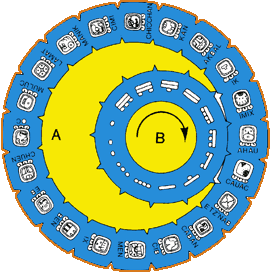The Maya civilization flourished as an important pre-Columbian Mesoamerican culture. The origins of this civilization may be traced to thousands of years ago and it came to an end by the Spanish conquest. Areas of concentration were Campeche, Chiapas, Quintana Roo, Tabasco and Yucatán in addition to the countries of Belize, Guatemala, Honduras and El Salvador.

Mayan Tzolkain Calender
The word “Tzolkin” is a compound word meaning, Count (tzol) and Day (kin). The Mayan Tzolkin calendar is comprised of a count of 260 days. There are 20 Day Keepers and 13 Tones. ( 20 X 13 = 260 ).
Ritual Calendar
They developed a sophisticated calendar on their own. The ritual calendar that developed in Mesoamerica used a count of 260 days. This calendar gave each day a name, much like our days of the week. There were 20 day names, represented by their respective symbols. The 260 day count of days is commonly known to scholars as the Tzolkin. It was combined with a was combined with a 365-day vague solar year known as the Haab.The Haab calendar was used for agricultural purposes but it does not have a set starting point in the solar year.
The Mayan calendar is associated with nine creation cycles, which represent nine levels of consciousness or Underworlds as symbolized by the Mayan pyramids. The Temple of Kukulcan is said to be a physical embodiment of the Mayan Calendar. For instance, there are 91 steps on each of the four sides (totaling 364) plus the top platform giving us 365 to match the days of a solar year. More intricate representations of time exist within the construction of the pyramid. Chichen Itza is a Mayan ruin site located in southern Mexico's Yucatan Peninsula, near Cancun.

20 days of Mayan Tzolkain Calender
Ancient Mayan Calender Belief
Some people believe that the Mayan calendar pointing to the end of dates meant the end of the world. Nothing in the mayan calander is capable of showing that the calendar was created to indicate an end point. It is said that the belief that the world would come to an end on December 21,2012 is a misunderstanding. In reality, the creation cycle that began as the First Father erected the World Tree will end on October 28, 2011. This day is also 13 Ahau in the sacred Mayan calendar, energy with great prophetical relevance.
The Mayan use of the calendar also deserves mention. It was mainly used for the purposes of calculating birth energies of individuals, determining holidays, divination of destinies and so on and so forth.
The following is a list of the day names and their respective meanings.
- Imix Water Lilly
- Ik' Wind
- Ak'bal Night
- K'an Corn
- Chikchan Snake
- Kimi Death head
- Manik' Hand
- Lamat Venus
- Muluk Water
- Ok Dog
- Chuwen Frog
- Eb Skull
- Ben Corn stalk
- Ix Jaguar
- Men Eagle
- Kib Shell
- Kaban Earth
- Etz'nab Flint
- Kawak Storm cloud
- Ahaw Lord
|




